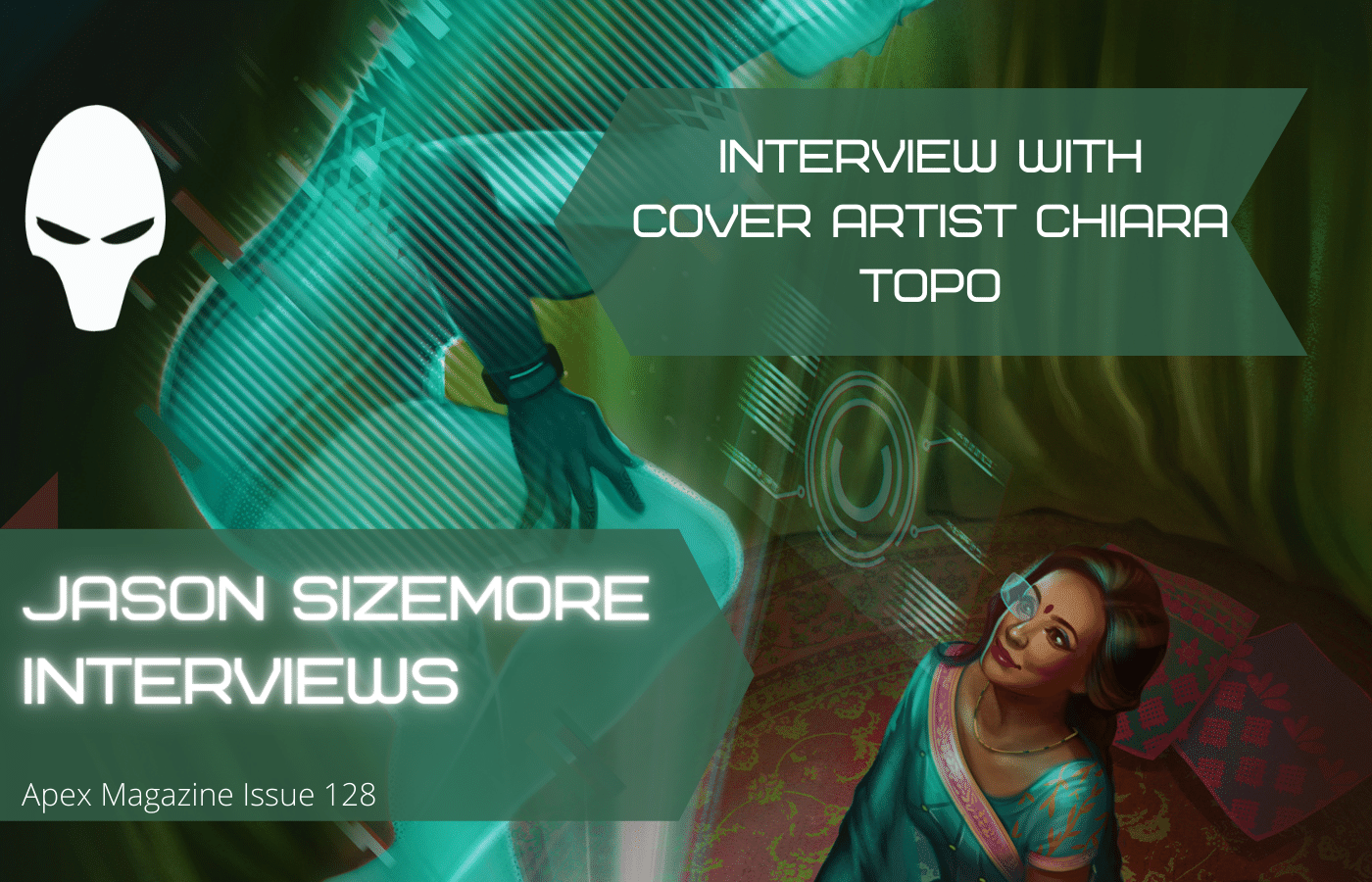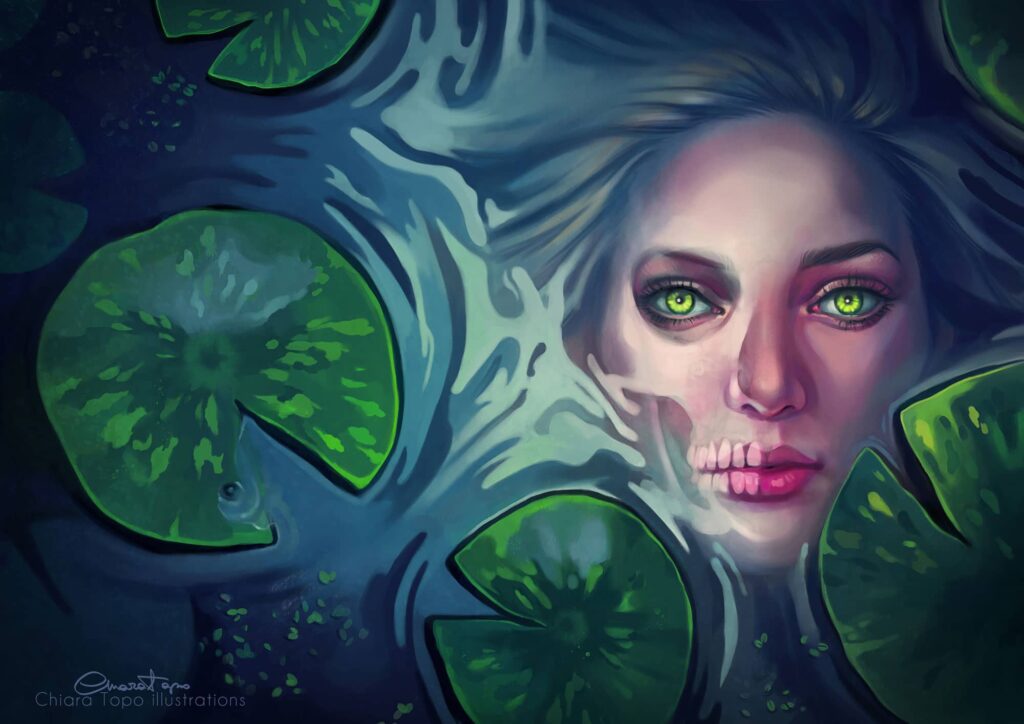
Finding the right cover artist for our International Futurists issue was likely the easiest part of pulling together this issue. The world is filled with fantastic genre illustrators and Apex Magazine has been fortunate to work with many notable names: Marcela Bolívar, Magdalena Pagowska, and Godwin Akpan, to name a few. When it was time to speak with our guest editor, Francesco Verso, about who we should approach for a cover piece, I was ready to toss some possibilities at him.
He immediately mentioned Chiara Topo.
I did a brief Google search, came upon Chiara’s portfolio, and immediately sent Francesco an email to contact Chiara posthaste!
Chiara Topo is a freelance digital artist from Rome, Italy. She graduated from a specialized art high school in Rome, and subsequently continued her studies at the International School of Comics, where she specialized in illustration. Most recently, her artwork can be found on the anthology Futuri uniti d’Africa (Future Fiction, 2021), the first African anthology of science fiction published in Italy.
Chiara’s portfolio can be found online via Instagram, Behance, and Artstation. Links are given below.
Instagram: https://www.instagram.com/kikimous3
ArtStation: https://www.artstation.com/chiarat
Behance: https://www.behance.net/chiaratopo8b74
§
APEX MAGAZINE: Welcome to the pages of Apex, Chiara, we’re delighted to have you be a part of International Futurists!
CHIARA TOPO: Hi, it’s a pleasure to be doing this interview with you guys. Thanks for having me. Also, I have to thank Francesco for always involving me in fantastic projects.
AM: Your bio states that you loved to draw as a child. When did you discover that you had an aptitude for art?
CP: I think I’ve always had an aptitude toward art for as long as I can remember.
When I was a child, long before I mastered any technique, my hands were always full of colored pencils, pastels, and paper, doodling whatever came to my mind. I spent my early years drawing and emulating my favorite characters from cartoons and comics. Back then, I didn’t know I could draw for a living. For me, it was simply something I needed to do the most.
As I grew older, and began attending art schools, I started to think that this passion could be a real career path for me.
While I know the illustrator job can be very challenging sometimes, I can’t imagine myself pursuing any other career than this.
AM: When I look at your art from a broader perspective, I’m struck by your color choices. You work with minimal textures that offsets your deep, memorable hues of red, brown, and blue. It’s a beautiful style that certainly makes an illustration stand out. When you approach a new project, how to you decide on your color palette?
CP: That’s a tricky question to answer!
The moment in which I decide the palette of an illustration is the most crucial part and perhaps, for this reason, also the most difficult one.
Color has a strong visual impact and can express many different aspects of an image. As we know, each color carries a universal, cultural, and emotional meaning that can determine the message of the illustration itself.
An image with a predominance of blue could suggest a cold and futuristic atmosphere, since blue is often associated with technology. But it can also convey water’s calm and peace. So, it is fundamental to know colors and their power.
That is why I leave this choice in an intermediate phase of the work, usually after having established the composition and the mood that the illustration will have.
AM: The artwork you created for the book Los ojos verdes by Gustavo Adolfo Bécquer is a great example of your use of color hues. But it also contains another aspect of your work that makes your pieces stand out. The woman in the water’s yellow-green (almost neon green) contrasts beautifully with the cold calmness of the blue water and green lily pads. Can you describe the process you go through when deciding on a work’s focal point?

CP: Establishing the focal point of an illustration is equally crucial to me. If the information is not clear, it will be difficult for the viewer to connect with the image. The artist’s goal lies in creating a guided path and inviting the observer to focus on the most relevant point of the piece. It is an active conversation you have with the audience.
In the case of the illustration you mentioned, I initially worked on several ideas before arriving at the draft that convinced me the most. My starting point, in this case, was the story. “Los Ojos Verdes” is about a hunter who, in an attempt to catch a deer during a hunt, finds himself wandering in a fountain inhabited by an evil spirit. This spirit has the appearance of a beautiful woman, and when the protagonist first meets her, she bewitches him through her captivating green eyes. For this reason, I decided to work on the draft that would allow me to highlight her distinctive characteristic, and I proceeded with a close-up of the woman. At this point, I made sure that the colors came to my aid, and I created the point of highest brightness and saturation in her eyes. Furthermore, the eyes are the main elements that we tend to look for in a face, and this only emphasized my focal point.
AM: Who are some of your artistic influences?
CP: Many artists have influenced my artistic journey. It would be hard to name them all.
As I mentioned before, when I was a kid, I was hugely inspired by cartoons and comics (coming especially from Disney and Japanese comics and anime).
Over time I discovered many new artists that inspired me for different reasons. Like Norman Rockwell for his ability to tell a story in one image. Or J. C. Leyendecker who, before Rockwell, became famous for his paintings of men and women with an elegant and idealized style.
I also have developed a great admiration for cinema, and I often find myself looking back at the photography of movies I love.
Generally speaking, my work tends to evolve every time I discover new artists, and I love this aspect; I am always hungry to learn and, in doing so, improve my art!
AM: Describe your dream project.
CP: Right now, I enjoy the work I’m doing on book covers and find it quite fulfilling. But it is a fact that working as an illustrator is often isolating as we spend most of the day alone at home. So, I’m trying to focus my time on projects that involve a group of people as well. I think it’s very thrilling to give life to a project as a team and exchange opinions between professionals!










